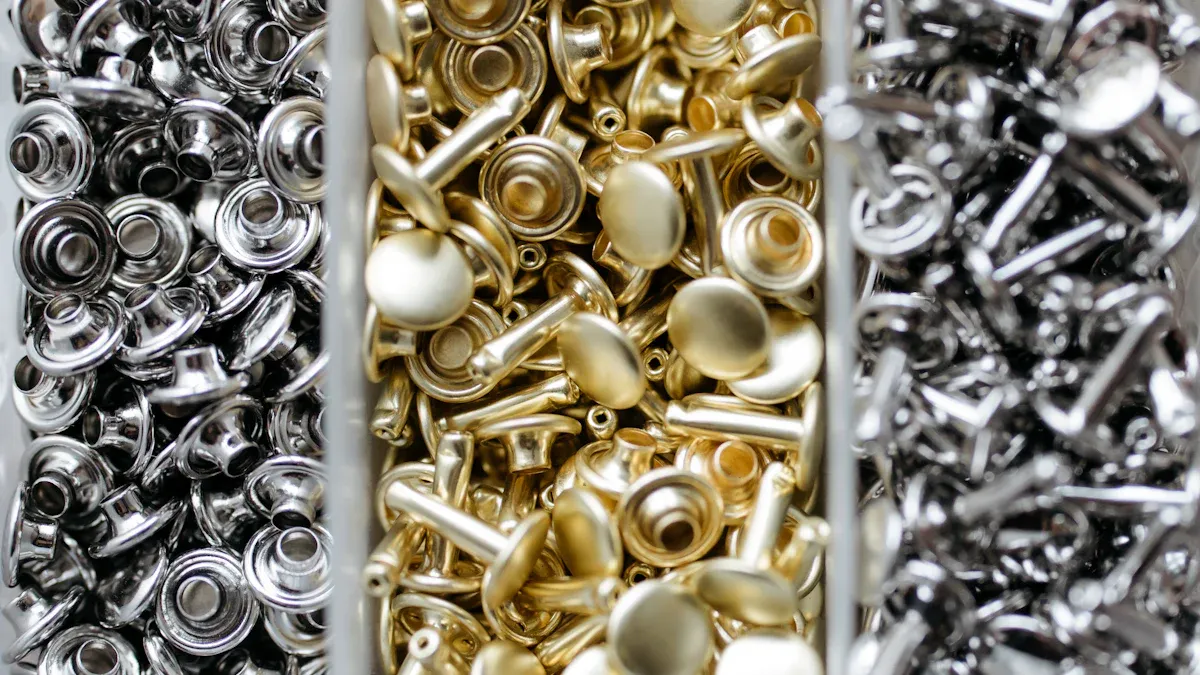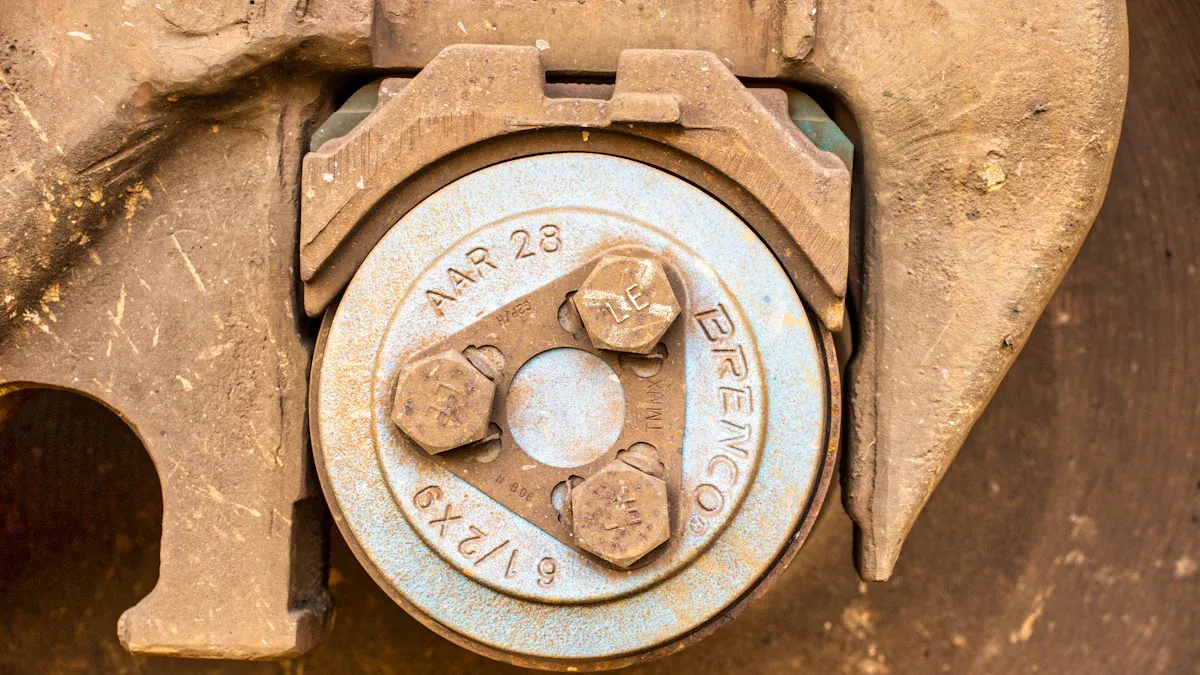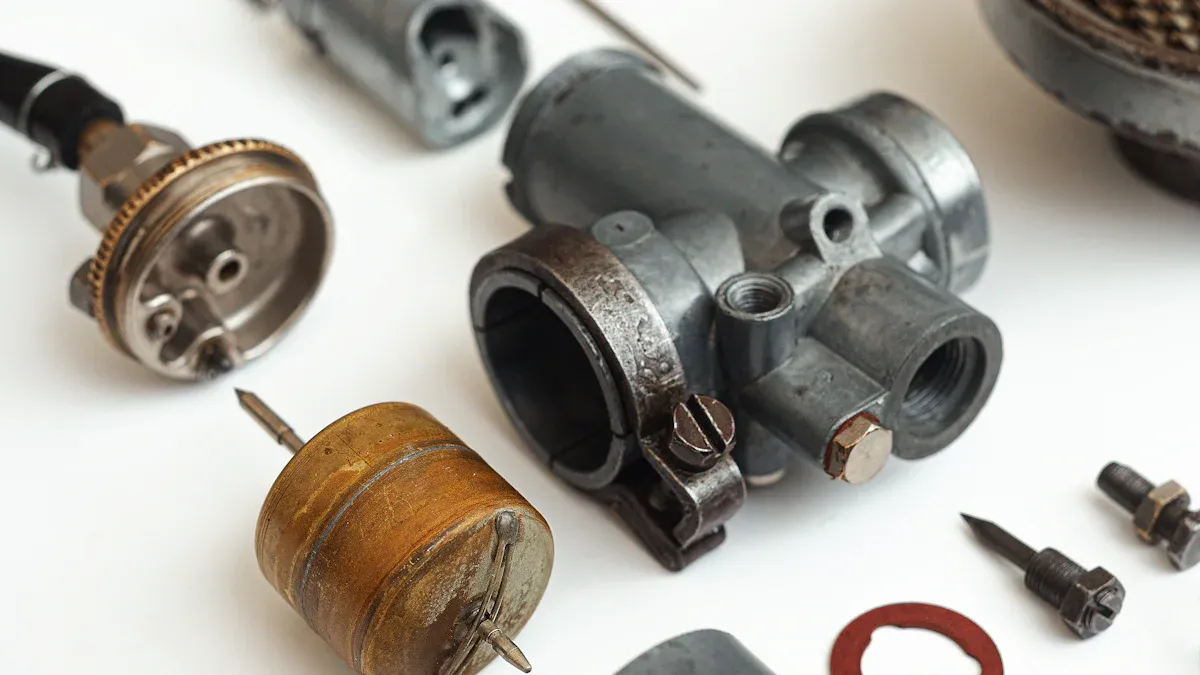 Tin bronze precision castings for bearing parts are essential in machinery, as they significantly reduce friction and wear between moving surfaces. These components guarantee smooth operation and prolong the lifespan of equipment. Renowned for their antifriction properties and durability, tin bronze precision castings are a preferred option across various industries. Additionally, tin bronze investment castings for bearing applications excel in managing heavy loads while resisting wear, making them crucial for high-performance scenarios.
Tin bronze precision castings for bearing parts are essential in machinery, as they significantly reduce friction and wear between moving surfaces. These components guarantee smooth operation and prolong the lifespan of equipment. Renowned for their antifriction properties and durability, tin bronze precision castings are a preferred option across various industries. Additionally, tin bronze investment castings for bearing applications excel in managing heavy loads while resisting wear, making them crucial for high-performance scenarios.
Key Takeaways
- Tin bronze castings lower friction and wear. They help machines work smoothly and last longer.
- Picking the right tin bronze alloy improves how it works. Think about weight limits and rust protection for your needs.
- Taking care of parts, like cleaning and oiling, keeps tin bronze bearings strong and dependable.
Tin Bronze Precision Castings for Bearing Parts

Key Properties of Tin Bronze
Tin bronze stands out among bearing materials due to its exceptional combination of mechanical and chemical properties. This alloy offers high wear resistance, making it ideal for demanding environments where durability is critical. Its low friction coefficient minimizes energy loss, ensuring smoother operation in machinery. Tin bronze also excels in corrosion resistance, particularly in marine conditions, where exposure to saltwater can degrade other materials.
Additionally, tin bronze demonstrates remarkable load and temperature endurance, maintaining reliability under high stress. Compared to statuary bronze, it offers superior strength, while its flexibility surpasses that of aluminum bronze. These properties make tin bronze a versatile choice for precision castings.
| Property | Description |
|---|---|
| Wear Resistance | High durability in demanding environments |
| Friction Coefficient | Low, reducing energy loss in moving parts |
| Corrosion Resistance | Excellent, especially in marine conditions |
| Load and Temperature Endurance | Reliable under high stress |
| Strength | Surpasses statuary bronze |
| Flexibility | Surpasses aluminum bronze |
Advantages of Tin Bronze in Bearing Applications
Tin bronze precision castings for bearing parts offer several advantages that set them apart from other materials. Their ability to handle heavy loads without deforming ensures reliability in high-performance machinery. The alloy’s low friction characteristics reduce wear and tear, extending the lifespan of components and minimizing maintenance costs.
In addition, tin bronze’s corrosion resistance makes it a preferred choice for applications in harsh environments, such as marine and industrial settings. Scientific studies have shown that alloying elements like Fe, Mn, and Si enhance tin bronze’s abrasion resistance, while rare earth additions improve tensile strength and refine its microstructure. These advancements further solidify its position as a top-tier material for bearing applications.
| Study | Findings |
|---|---|
| M. Aksoy and H. Turhan | Alloying elements improve sintering and abrasion resistance. |
| Qi Zhan Jun | S addition controls lead segregation during casting. |
| C Nobel | Rare earth and Pb additions enhance tensile strength and wear resistance. |
Common Uses of Tin Bronze Bearing Parts
Tin bronze bearing parts are widely used across various industries due to their reliability and performance. In the marine sector, they are essential for components exposed to saltwater, such as propeller shafts and rudder bearings. Industrial machinery relies on tin bronze bearings for their ability to handle heavy loads and resist wear during continuous operation.
Automotive applications also benefit from tin bronze’s low friction and high durability, ensuring smooth performance in engines and transmissions. The metal plain bearing market highlights the prevalence of bronze bearings, including tin bronze, in these sectors. Their popularity stems from their ability to deliver durability, reliability, and corrosion resistance in critical applications.
Manufacturing Process for Tin Bronze Bearing Parts

Material Selection and Preparation
The manufacturing process begins with selecting the right materials. Tin bronze alloys are chosen for their excellent mechanical properties, including wear resistance, corrosion resistance, and durability. The alloy composition, particularly the tin content, plays a crucial role in determining the final product’s performance. Studies have shown that adjusting the tin content can significantly enhance the material’s hardness and tensile strength.
| Study Year | Tin Content (wt%) | Microstructure Change | Mechanical Property Improvement | Source |
|---|---|---|---|---|
| 2023 | 1.0 | Columnar to equiaxed | Hardness +69%, Tensile Strength +28.4% | Properties and Applications of Bronze Alloys |
| 2024 | 5, 10, 15, 20 | FCC to FCC-BCC | Enhanced hardness, yield strength, and wear resistance | Properties and Applications of Bronze Alloys |
Once the alloy is selected, the raw materials undergo preparation. This includes cleaning and melting the metals to remove impurities. Proper preparation ensures the alloy’s consistency, which is critical for producing high-quality tin bronze precision castings for bearing parts.
Casting Techniques for Tin Bronze
Casting is a pivotal step in manufacturing tin bronze bearing parts. Foundries often use sand casting, centrifugal casting, or investment casting methods. Among these, investment casting is preferred for its ability to produce intricate shapes with high precision.
The rapid solidification process, which achieves cooling rates of up to 10⁶ degrees Celsius per second, has revolutionized casting techniques. This method creates fine-grained materials with superior mechanical properties compared to traditional chill-cast samples.
Centrifugal casting is another popular technique. It uses centrifugal force to distribute molten metal evenly, resulting in dense and defect-free castings. This method is particularly effective for cylindrical components like bushings and bearings. By combining advanced casting techniques with precise control over cooling rates, manufacturers can achieve exceptional quality and performance in tin bronze precision castings for bearing parts.
Machining and Shaping Processes
After casting, the components undergo machining to achieve the desired shape and dimensions. Modern machining techniques, such as CNC (Computer Numerical Control) machining, ensure high accuracy and repeatability.
- Dry machining with AlTiN-coated tools has proven effective for copper alloys like tin bronze.
- Optimal machining conditions include:
- Cutting speed: 120 m/min
- Feed rate: 0.25 mm/rev
- Depth of cut: 0.6 mm
These parameters help achieve excellent surface quality and dimensional accuracy. Studies also reveal that feed rate has a more significant impact on surface roughness and cutting force than other factors. By optimizing these conditions, manufacturers can enhance the efficiency and reliability of the machining process.
Finishing Methods for Precision and Durability
Finishing is the final step in the manufacturing process. It involves polishing, coating, and other treatments to improve the component’s surface quality and durability. Tin bronze’s natural corrosion resistance is further enhanced through finishing techniques.
For example, the patina that forms on bronze acts as a protective layer, preventing further corrosion. This property makes tin bronze ideal for marine applications, where components are exposed to harsh environments. Additionally, the alloy’s wear resistance ensures a longer operational life, even in high-friction applications like bearings and gears.
Customer feedback and case studies consistently highlight the importance of finishing in achieving precision and durability. These insights demonstrate how manufacturers deliver consistent product quality and meet the demands of various industries.
Quality Control in Tin Bronze Precision Castings
Inspection and Testing Procedures
Quality control ensures that tin bronze precision castings for bearing parts meet strict performance and durability standards. Manufacturers rely on a combination of inspections and tests to verify the quality of each component. Non-destructive testing (NDT) methods, such as X-ray and ultrasonic inspections, help detect internal flaws without damaging the part. These techniques are especially useful for identifying hidden defects like cracks or voids.
Hardness and tensile strength tests are also essential. They confirm that the material can withstand heavy loads and resist wear. Dimensional accuracy tests ensure that every part matches the required specifications. Continuous production monitoring further minimizes defects and maintains consistency.
| Certification/Process | Description |
|---|---|
| ISO 9001 | Ensures a robust quality management system. |
| ASTM compliance | Verifies that materials meet international standards. |
| Rigorous Testing | Includes hardness, tensile strength, and dimensional accuracy tests. |
| Non-destructive Testing | Uses methods like X-ray or ultrasonic inspections to detect internal flaws. |
| Production Monitoring | Continuous oversight to minimize defects and ensure consistency. |
Best Practices for Ensuring Precision
Precision is critical in manufacturing tin bronze bearing parts. Following industry standards like ISO 9001 and AS9100 helps maintain a strong quality management framework. Advanced measuring tools, such as Coordinate Measurement Machines (CMM), play a key role in achieving tight tolerances. These machines measure components with incredible accuracy, ensuring they meet design specifications.
Non-destructive testing techniques, including dye penetrant inspection, are also vital. They assess material integrity without causing damage. By combining these practices, manufacturers can produce reliable and durable components that perform well in demanding applications.
- Quality control ensures components meet essential specifications, enhancing performance and durability.
- Advanced measuring instruments, like CMM, are crucial for examining parts with tight tolerances.
- NDT techniques, such as X-ray and dye penetrant inspection, assess material integrity effectively.
Tools and Equipment for Quality Assurance
The right tools and equipment make all the difference in quality assurance. Coordinate Measurement Machines (CMM) are indispensable for checking dimensions with high precision. X-ray machines and ultrasonic devices are commonly used for non-destructive testing. These tools help identify internal defects that might otherwise go unnoticed.
Production monitoring systems also play a key role. They track every stage of the manufacturing process, ensuring consistency and reducing the risk of errors. By using these advanced tools, manufacturers can maintain the high standards required for tin bronze precision castings for bearing parts.
Addressing Challenges in Manufacturing
Preventing Casting Defects
Casting defects can compromise the quality and performance of tin bronze bearing parts. Shrinkage porosity, one of the most common issues, occurs during solidification. Manufacturers have found that adjusting the metal core diameter can significantly reduce these defects.
| Metal Core Diameter (mm) | Effect on Shrinkage Porosities |
|---|---|
| 6 | All shrinkage porosities in the ears vanished |
| 10-12 | Shrinkage porosities found only in the gate and riser, eliminated from the body |
| >12 | Shrinkage porosities reproduced |
| N/A | Total shrinkage porosity reduced by more than 60% in core-containing vessels during solidification |
By optimizing core sizes and using advanced simulation tools, manufacturers can predict and prevent defects before production begins. These measures ensure better casting quality and reduce material waste.
Managing Material Impurities
Impurities in tin bronze alloys can weaken the final product. Elements like lead or sulfur, if present in excess, can cause brittleness or uneven wear. Manufacturers address this by carefully controlling the alloy composition during the melting process.
Modern refining techniques, such as vacuum degassing, help remove unwanted gases and impurities. This process improves the alloy’s mechanical properties and ensures a uniform microstructure. By maintaining strict control over material purity, manufacturers produce components that meet high-performance standards.
Ensuring Consistency in Production
Consistency is key to producing reliable tin bronze bearing parts. Even small variations in alloy composition can lead to significant performance issues. For example, a 0.1% change in phosphorus content can alter electrical conductivity by 15%. Similarly, tensile strength variations in products from the same heat treatment process can exceed acceptable tolerances, leading to yield losses of over 12%.
To maintain uniformity, manufacturers use precise mixing and heat treatment methods. Automated systems monitor every step of production, ensuring consistent results. This attention to detail minimizes defects and guarantees that each component performs as expected.
Maintaining consistency not only improves product quality but also reduces waste and production costs.
Practical Insights and Applications
Tips for Choosing the Right Tin Bronze Alloy
Selecting the right tin bronze alloy can make a big difference in performance. Each alloy has unique properties that suit specific applications. For example, alloys with higher tin content offer better load-carrying capacity, while those with added lead improve lubricity and toughness.
| Property | Details |
|---|---|
| Load Carrying Capacity | Directly related to the amount of tin in the alloy. |
| Role of Lead | Enhances lubricity and toughness; provides good load carrying capacity. |
| Maximum Operating Temperature | Up to 450°F (230°C). |
| Maximum Load Capacity | Approximately 4,000 lbs. per square inch. |
| Corrosion Resistance | Important for applications in harsh environments. |
| Strength and Wear Resistance | Manganese bronze is recommended for high strength and durability. |
| Castability | Tin bronzes are excellent for complex castings. |
| Cost Considerations | High-lead tin bronzes balance performance and cost. |
When choosing an alloy, consider the operating environment. For harsh conditions, prioritize corrosion resistance. For heavy loads, focus on strength and wear resistance. Balancing performance and cost is also key, especially for large-scale projects.
Maintenance of Tin Bronze Bearing Parts
Proper maintenance keeps tin bronze bearings in top shape. Regular cleaning removes debris that could cause wear. Lubrication is essential to reduce friction and extend the lifespan of the parts. Use lubricants compatible with the alloy to avoid chemical reactions.
Inspect the bearings periodically for signs of wear or damage. Replace worn-out components promptly to prevent further issues. In marine environments, rinse parts exposed to saltwater to minimize corrosion. These simple steps ensure reliable performance and reduce downtime.
Industries That Rely on Tin Bronze Bearings
Tin bronze bearings play a vital role in many industries. Their durability and resistance to wear make them indispensable in demanding applications.
| Sector | Application of Tin Bronze | Key Properties Utilized |
|---|---|---|
| Automotive | Used in various components requiring durability and wear resistance. | Wear resistance, strength |
| Aerospace | Critical for components like bushings and landing gear due to performance under stress. | Mechanical integrity, corrosion resistance |
| Marine | Extensively used in hardware and components exposed to saltwater. | Corrosion resistance, wear resistance |
| Industrial Machinery | Used in bearings, gears, and valves for robust machinery. | Strength, wear resistance |
| Electrical and Electronics | Suitable for connectors and switches due to conductivity. | Electrical conductivity, corrosion resistance |
From automotive to aerospace, tin bronze bearings ensure smooth operation and long-lasting performance. Their versatility and reliability make them a trusted choice across these sectors.
Tin bronze precision castings play a vital role in ensuring machinery runs smoothly and lasts longer. Manufacturing these parts involves careful material selection, precise casting, and thorough finishing. Quality control guarantees reliability, while choosing the right alloy enhances performance. By following these steps, manufacturers deliver durable and efficient components for various industries.
FAQ
What makes tin bronze better than other materials for bearings?
Tin bronze offers excellent wear resistance, low friction, and corrosion resistance. These properties make it ideal for high-performance applications in harsh environments.
How can manufacturers prevent defects in tin bronze castings?
They use advanced simulation tools, optimize core sizes, and control alloy composition. These steps ensure high-quality castings with minimal defects.
Are tin bronze bearings suitable for marine applications?
Yes, tin bronze resists corrosion in saltwater environments. This makes it a reliable choice for marine components like propeller shafts and rudder bearings.
